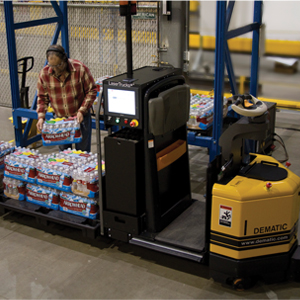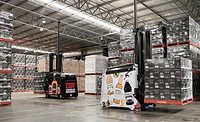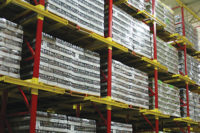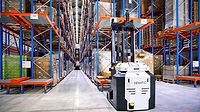
|
|
LaserTruck+, an alliance between Dematic Corp. and Crown Equipment Corp., created an integrated solution that combines Dematic’s picking and voice software suite and automated guided vehicle guidance technology with Crown’s PC4500 series rider pallet truck. |
As beverage companies look at ways to automate warehouse facilities, equipment manufacturers say that more beverage-makers are looking to automated guided vehicles (AGVs). The Automatic Guided Vehicle Systems Industry Group of the Material Handling Industry of America (MHIA) stated in its fall 2010 quarterly report titled “New Paths for Guided Vehicles” that automation today is more flexible and more accommodating to changing operational requirements.
“AGVs are being used more and more in the beverage industry because they provide flexibility,” says Sarah Carlson, marketing director of Daifuku Webb, a subsidiary of Daifuku Co. Ltd. “… Really it’s adding the element of automation to your facility or your warehouse.”
A subsidiary of Daifuku Co. Ltd., Jervis B. Webb, Farmington Hills, Mich., offers a flexible option with its SmartCart Automatic Guided Cart that is guided by magnetic tape.
“It’s very easy to change the guide path to install them,” Carlson says. “Customers with very little training are able to make their own changes to the system. If they need to go a different route, that’s easy enough to do [by] just pulling up the tape and reapplying, so that certainly is helpful in terms of offering flexibility.”
Other forms used for guidance with AGVs on the market include laser, inertial and wire systems.
In addition to the flexibility and automation aspect of AGVs, the vehicles also appeal to companies looking to cut costs.
“We see a strong commitment by beverage producers to eliminate all unnecessary cost in their operation,” says Mark Longacre, marketing manager for JBT Corp., Chicago. “In the past, the focus has been on optimizing the beverage production and bottling processes. Now, attention has turned to other areas of the facility such as at the end of the production line, in the warehouse and at the shipping [and] receiving docks. It is in these areas of the facility that AGVs can reduce costs for the beverage producers.”
For the shipping and receiving docks, Longacre says, AGVs can unload and store empty bottles or other materials and automatically load standard, over-the-road trailers with pallets of finished goods.
Jervis B. Webb also offers this capability with its SmartLoader, which is equipped with LADAR technology. The SmartLoader can remove loads from a trailer and deliver them anywhere in a warehouse, the company says. It also moves loads to and from palletizers, automated storage and retrieval systems, staging areas, as well as any conventional over-the-road trailer, Jervis B. Webb says.
Transportation solutions
Integrating AGVs in a warehouse can offer many solutions for a beverage producer, JBT’s Longacre says.
“Typically our systems can be used to move pallets from a palletizer to a stretch wrapper, from a stretch wrapper to a storage area or warehouse, and from the storage warehouse to shipping,” he says.
JBT’s AGVs also can interface with racking systems, block stack pallets and deliver to and from automated storage and retrieval systems, Longacre says.
“AGV systems are very tightly integrated with the controls and software used to manage operations in production and the warehouse,” he says. “There is constant two-way electronic communication between the systems for on-time delivery and removal of the appropriate materials.”
Manufacturers also continue to innovate with AGVs. “In the past several years, I have seen AGVs become much more user friendly,” Longacre says. “The days of long installations that required programmers and engineers to support operations are in the past. We will see that trend continue as we develop more advanced tools allowing self diagnosis and even quicker recovery from stoppages.”
Other ways manufacturers are looking to improve the AGV market is with its engineers. “We need some of the ideas that gamers are using to develop software and controls to migrate into our industry,” says John Hayes, manager of AGV sales for Dematic Corp., Grand Rapids, Mich. “We need a new and fresh way to design, manufacture, control and implement AGV systems.”
Manufacturers also are finding new ways to upgrade their products. Earlier this year, Dematic announced an alliance with Crown Equipment Corp. known as LaserTruck+. The first AGV from the alliance combines Crown’s PC4500 series rider pallet truck with voice picking technology and software suite from Dematic, Hayes says.
“In essence what the system becomes is a vehicle that can be automatically directed to a picking zone, automatically indexed to the next picking location within that zone as the associate is directed by the voice system to complete his picks, and then get automatically routed to the next assignment for the vehicle — whether that’s to another pick zone to complete the picks for a pallet, a drop off location, a stretch wrapper or the shipping dock,” Hayes says.
Hayes says partnering with Crown allows Dematic to have the economies of scale to drive down costs, which can help open the AGV market to smaller companies and those that don’t operate on two or three shift schedules.
Egemin Automation Inc., Holland, Mich., offers Hybrid AGVs through its alliance with Mitsubishi Caterpillar Forklift America Inc. (MCFA), Houston. Morphing manual and automatic operations onto a standard off-the-shelf forklift gives an operator the ability to drive the vehicle manually and then place the forklift back into fully automatic laser guidance mode, Egemin says.
Although customers look to AGVs for cost savings and flexibility, companies also want to be sure operations remain productive.
“AGVs generate a general increase in productivity [and] output because of the timely arrival [and] removal of materials,” JBT’s Longacre says.
Tracking abilities with AGVs also enable customers to see how effective operations are.
“From a material tracking and control aspect, AGVs control and track every move of a product within a facility as well as maintain a constant inventory,” Dematic’s Hayes says. “In many cases, there is a 35 percent productivity improvement with AGV system implementation.”
AGVs also allow beverage companies to allocate plant personnel to more value-added operations within facilities, Hayes adds.
When it comes to operating a warehouse, safety also remains a concern. Hayes says AGVs can benefit individuals because of safety elements.
“AGV systems work well in environments that truly are hazardous to humans, like freezers,” he says. “Dematic has an AGV rate to negative 20 degrees [Fahrenheit] with no reduction in productivity that is seen by workers in these very dangerous temperatures.”
Even in normal warehouse conditions, AGVs can provide a safety element. “AGVs operate in a very predictable and controlled manner, so there is also a general improvement in safety for pedestrians and other mobile vehicles in the area,” JBT’s Longacre says.
“AGVs can be very safe, so that is a big benefit that a lot of customers are seeing is the safety benefit,” Daifuku’s Carlson says. “They’re equipped with laser bumpers now and will stop if anything goes in their path.” BI




